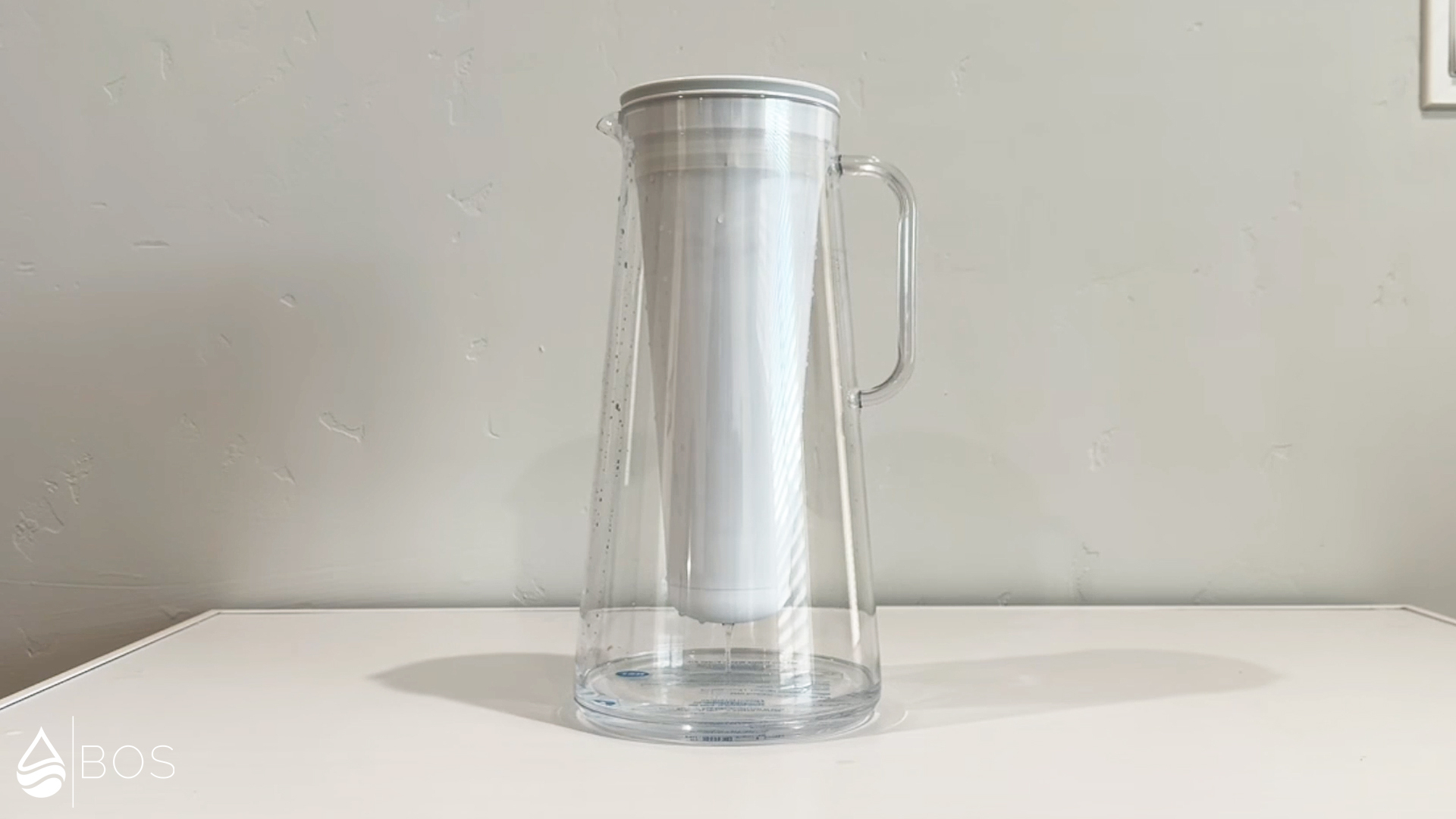This page contains affiliate links. If you buy a product or service through such a link, we earn a commission at no extra cost to you. Learn more.

Our Verdict (Best for)
The LifeStraw Home 10-Cup water filter pitcher could be ideal if bacteria/cyst removal is your top concern – based on LifeStraw’s own test data. What’s more, the LifeStraw holds a few important NSF certifications for lead, mercury, and microplastics. Plus, there’s additional NSF and other testing aside from bacteria/cyst removal. Our own lab testing revealed solid filtration effectiveness, too, and the filtered water had a flawless taste and smell. Some cons: 1.4 ppb methylene chloride that appeared post-filtration (so below the strictest health guideline). Usability is also a bit of a hit-or-miss – the pitcher may drip when pouring, and then there’s also the bottom-heavy design and high handle. Costs? Slightly above average.
The LifeStraw Home 10-Cup is a water filter pitcher. It’s designed for use as a drinking water filter and can purify both tap water and properly disinfected well water.
As usual, we’ve tested the pitcher with our own hands:
- Hands-on experience: We assembled, primed, used, and maintained it.
- Filtration effectiveness: We sent an unfiltered and a filtered tap water sample to a professional lab for analysis in order to determine real-life contaminant reduction capabilities. Plus, we checked for NSF certifications and other test data.
- More testing: We performed a taste & odor test as well as a filtration speed test.
- All other product aspects: We considered initial + long-term cost, product warranties, additional features, frequent customer complaints, etc.
Contents

Overall Rating: /5.00
Filtration: /5.00
Usability: /5.00
Costs: /5.00
| Type: | Water Filter Pitcher |
| Price (Jan 20, 2025, w/o Short-Term Sales): | $49.95 |
| Estimated Yearly Cost (Mar 19, 2024): | ~$150 |
Overall Rating: /5.00
What We Like Most
- Filtered water tasted and smelled 100% clean.
- Effective for bacteria & cyst removal based on 3rd-party testing against NSF standards.
- NSF/ANSI certifications against standards 42, 53, and 401.
- Additional testing for 58 contaminants against NSF standards 53, 401, P231, and P473, and other non-NSF standards.
- Easy to set up and maintain.
- 3-year (limited) warranty.
What We Don’t Like
- Methylene chloride detected in our filtered water (below the strictest OEHHA health guidelines).
- Only “important” NSF-certified contaminants are lead, mercury, and microplastics.
- Slow filtration speed.
- Bottom-heavy design and high handle make it a little awkward to use. It also pours slowly and may drip.
- No filter life indicator.
- A bit expensive to maintain with its short 40-gallon carbon filter lifespan (but microfiltration membrane lasts 264 gallons).
- Third-party customers complained about slow filtration, leaking, and cracked plastic.
How the LifeStraw Home 10-Cup Compares to…
10 Other Water Filter Pitchers
In this video, Mike explains why we think the LifeStraw Home 10-Cup could be the ideal pitcher for bacteria & cyst reduction.
Please note: Our full guide on the best water filter pitchers is available here.
Video Chapters + Comparison Sheet
- Link to Comparison Sheet
- 00:00 – Intro
- 00:58 – Our 11 Pitchers
- 02:00 – How We Tested & Ranked
- 04:29 – Pitcher Assembly & Filter Priming
- 05:21 – Sampling Process
- 06:18 – Taste & Odor Test
- 06:58 – Speed Test
- 08:28 – Best Overall (Clearly Filtered)
- 12:27 – Best for Usability + Affordability (Waterdrop)
- 15:45 – Best for Bacteria & Cyst (LifeStraw)
- 18:30 – Best for Nitrate (ZeroWater)
- 23:00 – Best for Fluoride
- 23:39 – Summary
Full Analysis of the LifeStraw Home 10-Cup
Filtration: /5.00
1. Lab Results: /5.00
Remember that our before vs after lab comparison is not an exact science. It’s informational and subject to variability, inaccuracies, and interferences caused by natural fluctuations in water quality, accidental contamination, human error, instrumentation issues, and more. Furthermore, our lab-testing is limited to those contaminants present in our water supplies and at their respective concentrations. As such, it can only give us a general idea for how effective a certain water treatment product might be.
Lab Results Chart
| Potentially Harmful | Aesthetic Issues | Feed Water Level | Filtered Water Level | Reduction Rate | |
| Water Disinfectants | |||||
| Chlorine (mg/L) | ✖ | ✖ | 0.2 | 0 | 100% |
| Disinfection Byproducts | |||||
| Bromodichloromethane (µg/l) | ✖ | 0.58 | 0 | 100% | |
| Bromoform (µg/l) | ✖ | 0.75 | 0 | 100% | |
| Dibromochloromethane (µg/l) | ✖ | 0.94 | 0 | 100% | |
| Metals | |||||
| Copper (mg/L) | ✖ | ✖ | 0.01 | 0 | 100% |
| Barium (mg/L) | ✖ | 0.01 | 0 | 100% | |
| Boron (mg/L) | ✖ | 0.04 | 0.02 | 50% | |
| Lithium (mg/L) | ✖ | 0.01 | 0 | 100% | |
| Strontium (mg/L) | ✖ | 0.18 | 0 | 100% | |
| Salts | |||||
| Nitrate (N) (mg/L) | ✖ | 1.65 | <0.5 | Anywhere Between 70% and 99% | |
| Fluoride (mg/L) (Flawed?) | ✖ | 0.46 | 0.43* | 7%* | |
| Other | |||||
| Uranium (µg/L) | ✖ | 7 | 1 | 86% | |
| Aesthetic Parameters | |||||
| Hardness (mg/L) | ✖ | 111.9 | 3 | 97% | |
| Impurities NOT Detected in Unfiltered Tap Water Sample | |||||
| Aluminum (mg/L) | ✖ | ✖ | 0 | 0.01 | |
| Iron (mg/L) | ✖ | 0 | 0.04 | ||
| Methylene Chloride (µg/l) | ✖ | 0 | 1.4 | ||
| *Due to known interferences of the applied testing method, we assume fluoride levels must be taken with a grain of salt. | |||||
| Explanation: | |||||
| Full Removal | |||||
| Considerable Reduction | |||||
| Concentration More Than Double of Unfiltered Water Sample | |||||
| Potential Leaching Reached or Exceeded the Strictest Public Health Guideline We Could Find | |||||
*100% means reduction to below the minimum detection level. To learn more about our testing procedures check our editorial guidelines.
Link to Filtered Water Report
Link to Unfiltered Water Report
Usability: /5.00
Costs: /5.00
Please note: This page is still a work in progress. Additional content and details will be added shortly – stay tuned!


